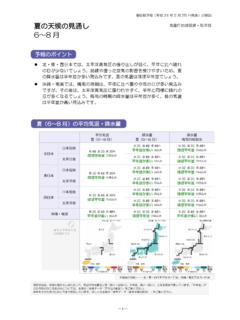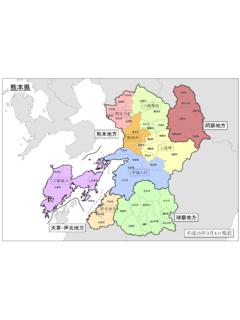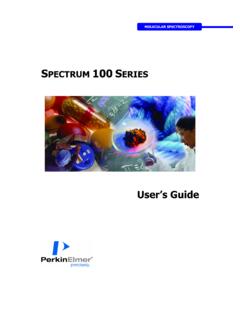Transcription of Chapter 3 Measurement of Humidity
1 IChapter 3 Measurement of Humidity CONTENTS Definitions and units .. 1 (1) Vapor pressure .. 1 (2) Saturation vapor pressure .. 1 (3) Dewpoint temperature .. 1 (4) relative Humidity .. 1 Hygrometers .. 1 Psychrometer .. 1 (1) Principle of Measurement .. 1 (2) Structure and composition .. 1 (3) Psychrometric formula and psychrometric table .. 2 (4) Calculations of vapor pressure, dewpoint temperature, and relative Humidity .. 3 Calculation of vapor pressure .. 3 Determination of dewpoint temperature .. 5 Calculation of relative Humidity .. 5 (5) Precautions for using the aspirated psychrometer .. 6 (6) Sources to cause errors .. 7 (7) Maintenance .. 7 Routine maintenance.
2 7 Periodic maintenance .. 7 (8) Calibration .. 8 (9) Repair .. 8 (10) Transportation and installation .. 8 Hair hygrometer .. 9 (1) Principle of Measurement and structure .. 9 (2) Precautions for using the hair hygrograph .. 10 (3) Sources to cause errors .. 10 (4) Maintenance .. 11 Routine maintenance .. 11 Periodic maintenance .. 11 ii(5) Calibration .. 11 (6) Repair .. 11 (7) Transportation and installation .. 12 Electronic hygrometer (capacitive type) .. 13 (1) Structure and composition .. 13 (2) Characteristics of the sensor .. 14 (3) Sources to cause errors .. 14 (4) Maintenance.
3 14 Routine maintenance .. 14 Periodic maintenance .. 14 (5) Calibration .. 15 (6) Repair .. 15 (7) Transportation and installation .. 15 Chilled-mirror dewpoint hygrometer .. 15 (1) Structure and composition sensor mirror .. 15 (2) Structure .. 16 (3) Error factor .. 16 (4) Maintenance .. 16 (5) Calibration .. 16 (6) Repair .. 16 (7) Transportation and installation .. 16 Example of calibration .. 17 (1) Measurement and calibration with chilled-mirror dewpoint hygrometer .. 17 (2) Preparation .. 17 (3) Measurement .. 18 1 Chapter 3 Measurement of Humidity Definitions and units (1) Vapor pressure Vapor pressure is the partial pressure of water vapor in the air, expressed in hPa.
4 (2) Saturation vapor pressure Saturation vapor pressure is the vapor pressure that is in a thermodynamic equilibrium with the surface of water or ice, expressed in hPa. (3) Dewpoint temperature Dewpoint temperature is the air temperature at which the moist air saturates respect to water at a given pressure. The dewpoint temperature is usually equal to or lower than the actual air temperature. The temperature at which moist air saturates with respect to ice is called the frost point temperature. the unit of these temperatures is C. (4) relative Humidity As shown below, relative Humidity (H) is the ratio of the vapor pressure (e) of the moist air to its saturation vapor pressure (es) at its temperature, which is expressed in %.
5 H = (e/es) 100 % H = (e/esw) 100 % H = (e/esi) 100 % where Hw and esw are the saturation vapor pressure with respect to water, and Hi and esi are the saturation vapor pressure with respect to ice, respectively. Hygrometers Psychrometer (1) Principle of Measurement When water or ice covers the bulb of a thermometer (wet-bulb), latent heat is removed from the surface of the bulb as the water evaporates, and the wet-bulb temperature becomes lower than the air (dry-bulb) temperature. At a lower Humidity , water evaporates more actively, so that the wet-bulb temperature lowerssharply. The aspirated psychrometer measures Humidity by measuring the difference between the dry-bulb temperature and wet-bulb temperature.
6 (2) Structure and composition The psychrometer consists of two thermometers of the same specifications, which are suspended side by side in the air. One of them measures the actual air (dry-bulb) temperature while the other, whose bulb is covered with a wet-bulb temperature. 2 Psychrometers are classified into the non-aspirated type psychrometer (portable aspirated psychrometers and sling psychrometers) and the aspirated type psychrometers (Assuman type aspirated psychrometer and JAM type aspirated psychrometers). Aspirated psychrometers are designed to keep the constant flow of air over around the bulbs.
7 The structure and composition of the Assuman type aspirated psychrometer, which is commonly used in Japan, and described below. Figure shows the structure of the Assuman type aspirated psychrometer. The psychrometer consists of two enclosed scale type mercury thermometers, which can read temperature in increments of C. One of them is called a dry-bulb thermometer, which measures actual air temperature and the other is called a wet-bulb thermometer, which ismeasures the temperature of wet-bulb which covered with a wet sleeve. The wet sleeve is a white thin cotton cloth soaked with water. The external and internal cylinders of a metal aspiration tube protect the bulbs from precipitation and radiation of direct sunlight.
8 As shown in figure , air floe with a velocity of m/s enters from the bottom with an electromotive fan or a spring fan. The time constant of the psychrometer is about 40 seconds. A squirt is used to feed water to the wet sleeve of the wet-bulb or to suck excess water from it. (3) Psychrometric formula and psychrometric table When the air steadily flows around the wet-bulb, the wet-bulb temperature falls below the air temperature by water evaporation from the surface of the wet-bulb. When the heat flow moving into the wet-bulb from the ambient air has reached equilibrium with the latent heat flow removed from the wet-bulb by evaporation, the following equation, called the Sprung psychrometric formula, is derived with the Assuman type aspirated psychrometer, e= ew- (A/755) p (t-tw).
9 (1) where A/755: Psychrometer constant, A is when the wet-bulb is not frozen and when it is frozen. E , e: Vapor pressure hPa ew: Saturation vapor pressure ,hPa Figure of Assuman type aspirated psychrometer 3,,p: Atmospheric pressure hPa , , ,,,t: Dry-bulb temperature C ,, ,tw: Wet-bulb temperature C Vapor pressure is calculated with this equation (1). Table and Table show the saturation vapor pressure for water and ice as a function of temperature. The second term on the right side of the equation (1) is calculated a function of p and (t-tw), which is tabulated as the vapor pressure table in Table and Table for the unfrozen and frozen wet-bulb.
10 (4) Calculations of vapor pressure, dewpoint temperature, and relative Humidity The vapor pressure, dewpoint temperature, and relative Humidity are calculated from the Measurement with the aspirated psychrometer using the tables described above. Calculation of vapor pressure 1) Make correction of the instrumental error of the dry-and wet-bulb thermometer. 2) Using Table or , determine the value of the saturation vapor pressure for water (ew) or ice (ei) as a function of the wet-bulb thermometer temperature (tw). Table Saturation vapor pressure for water 4 Table Saturation vapor pressure for ice Table Vapor pressure for unfrozen wet-bulb 5 3) Using Table and calculate the second term on the right side of the equation (1) as a function of atmospheric pressure (p) and (t-tw), where t is the dry-bulb thermometer temperature.












